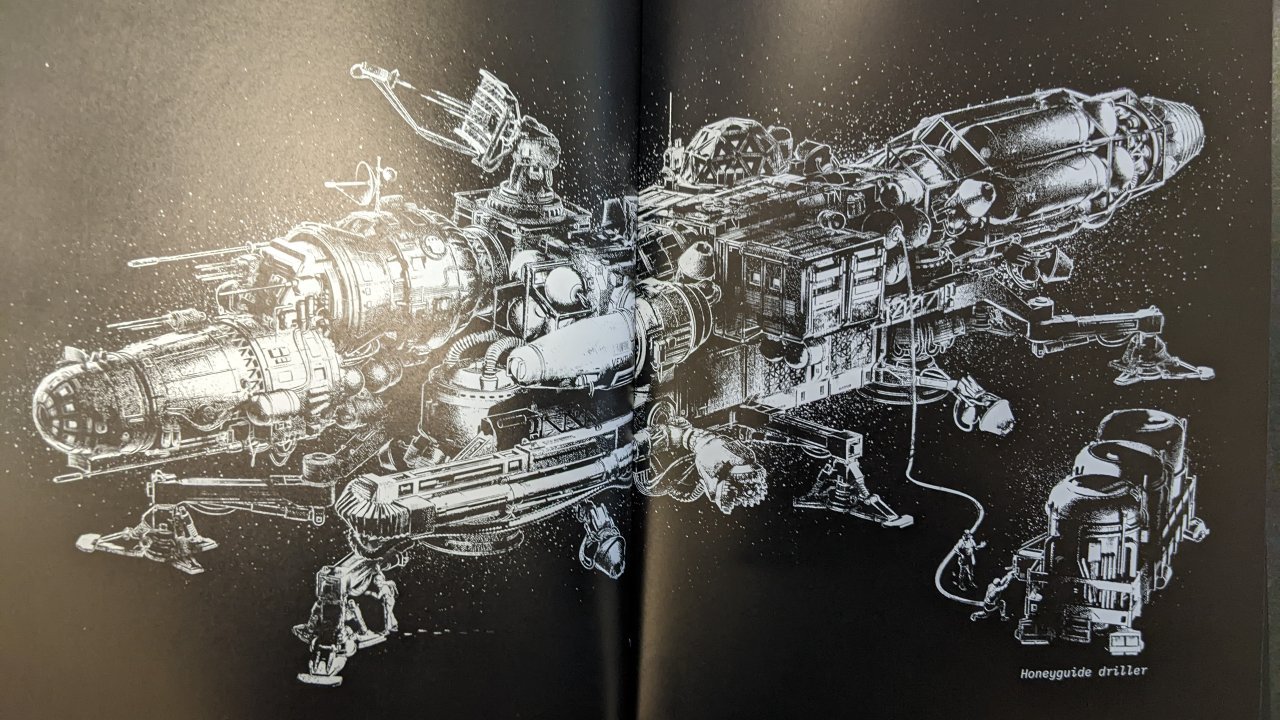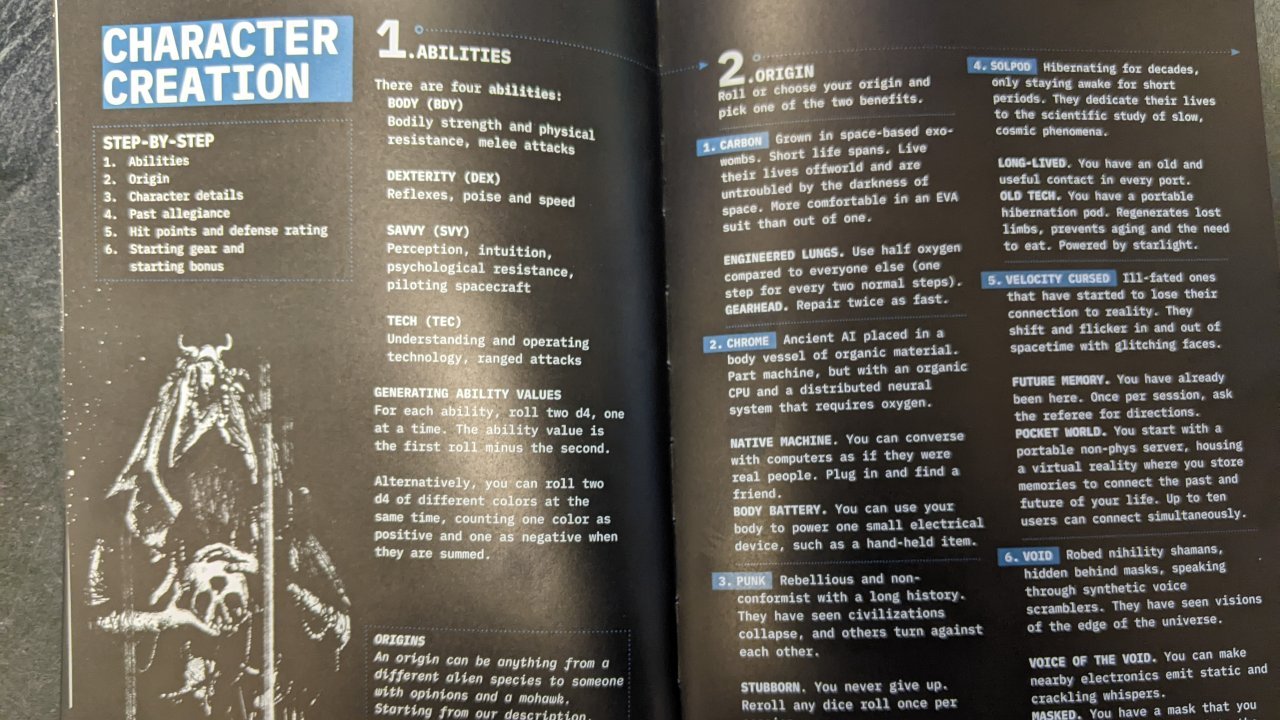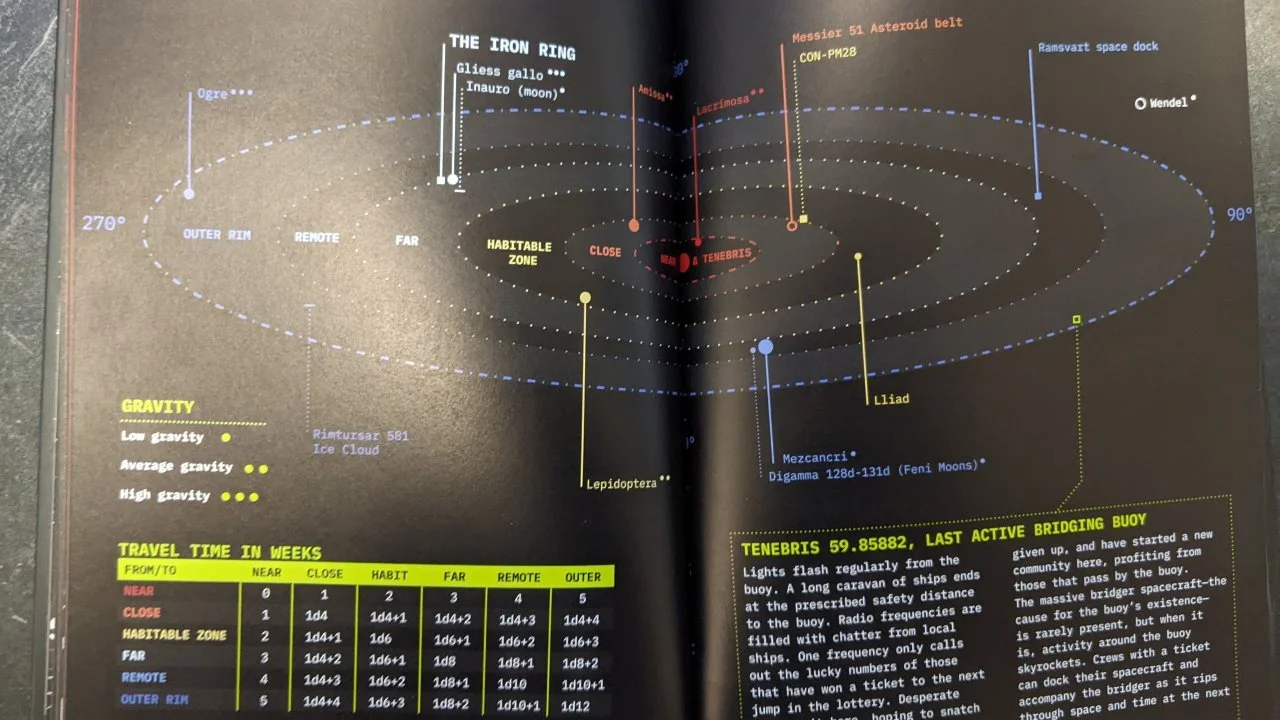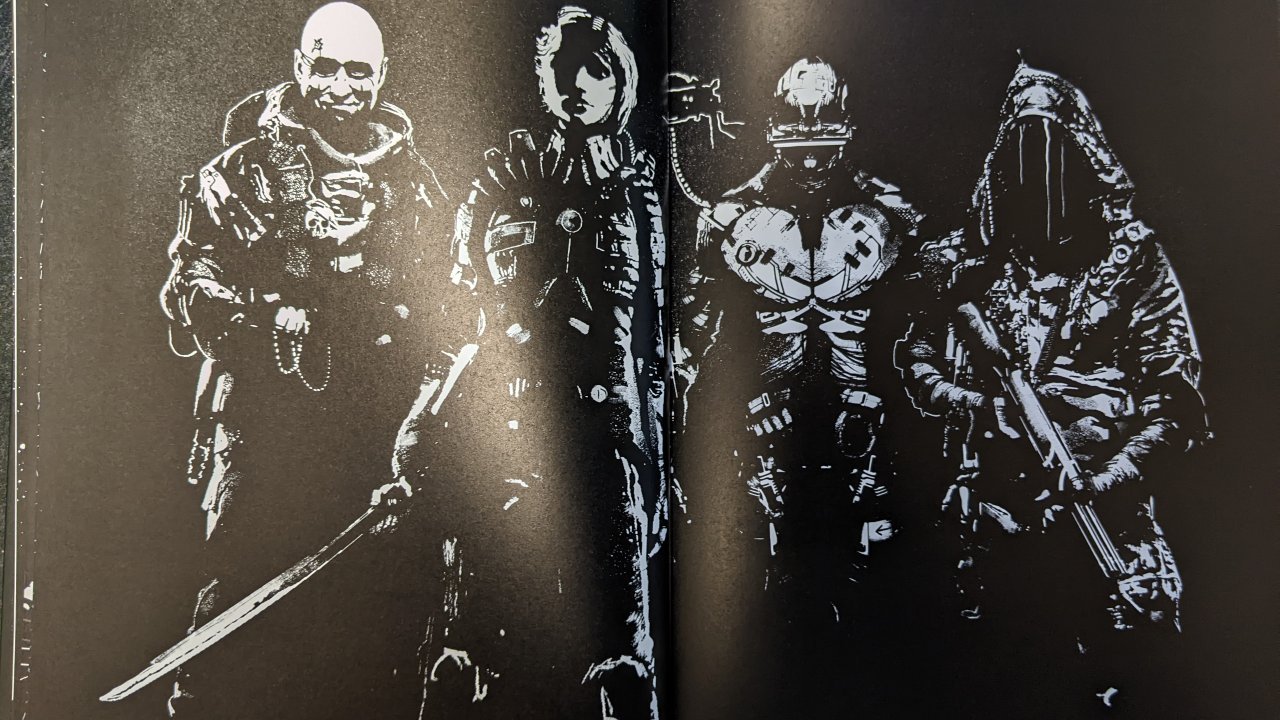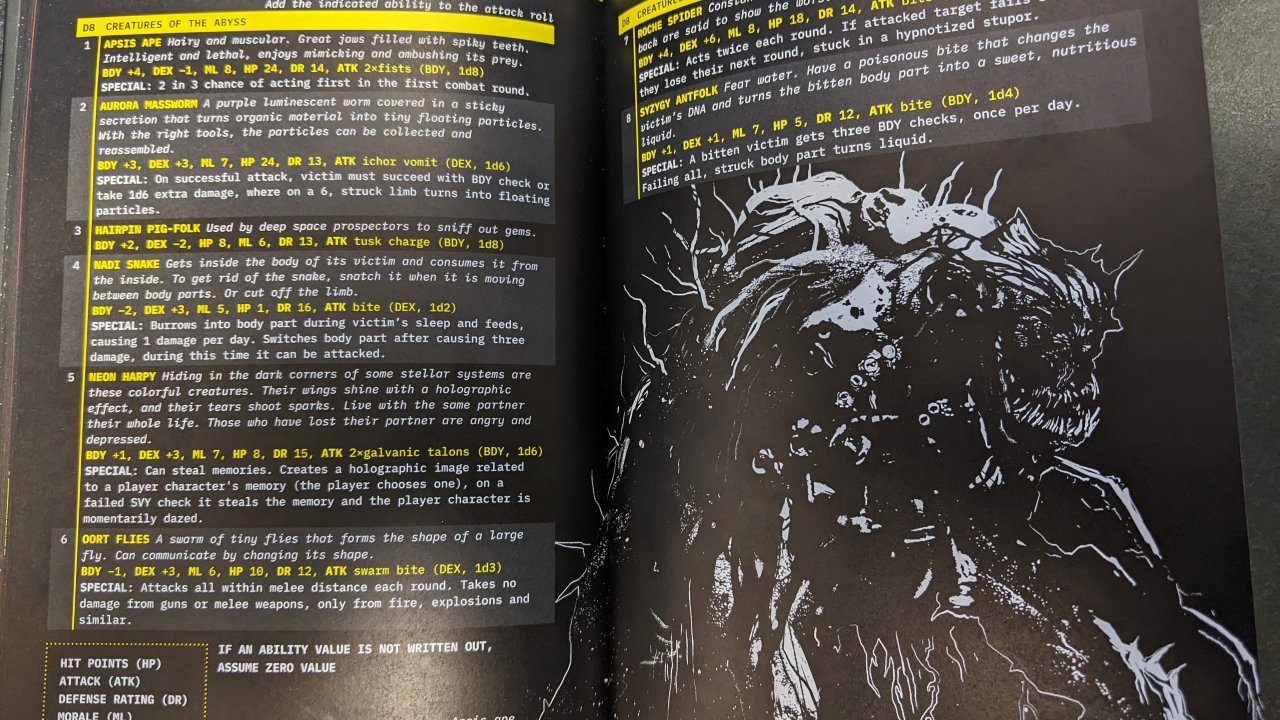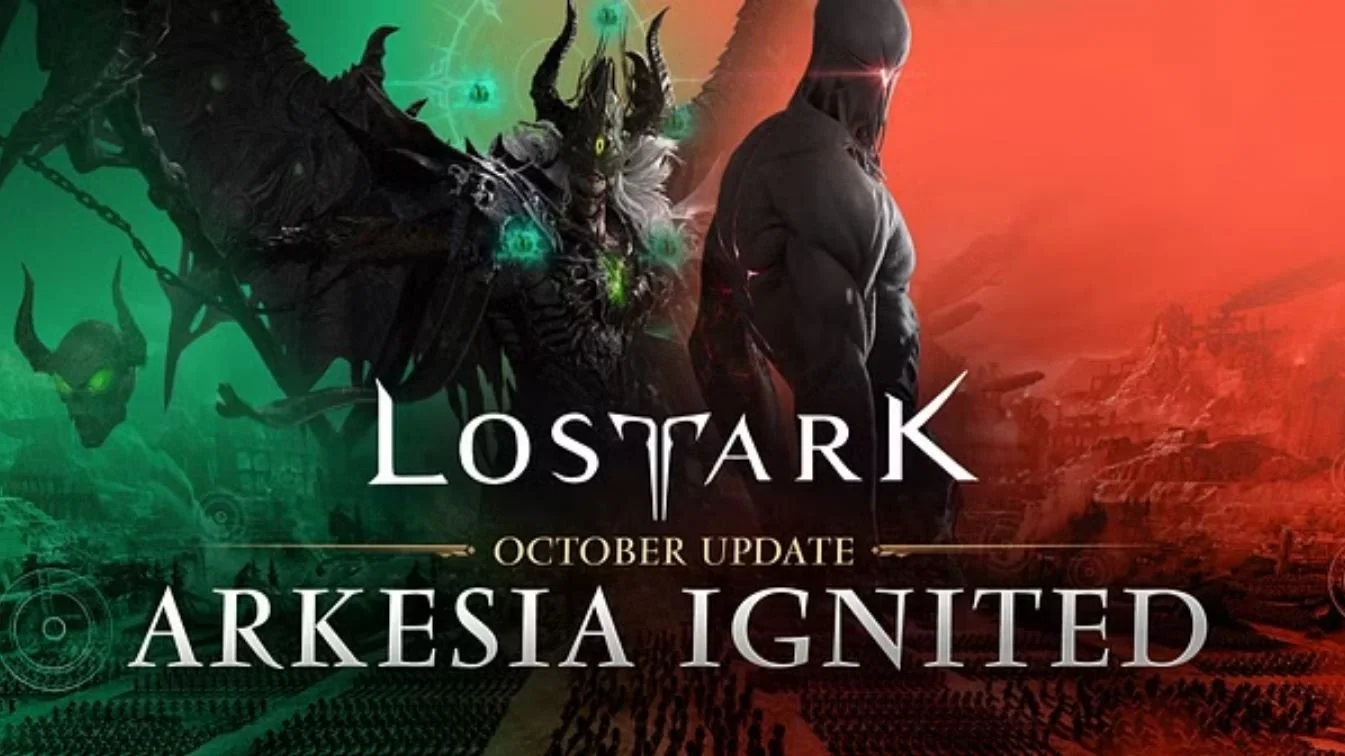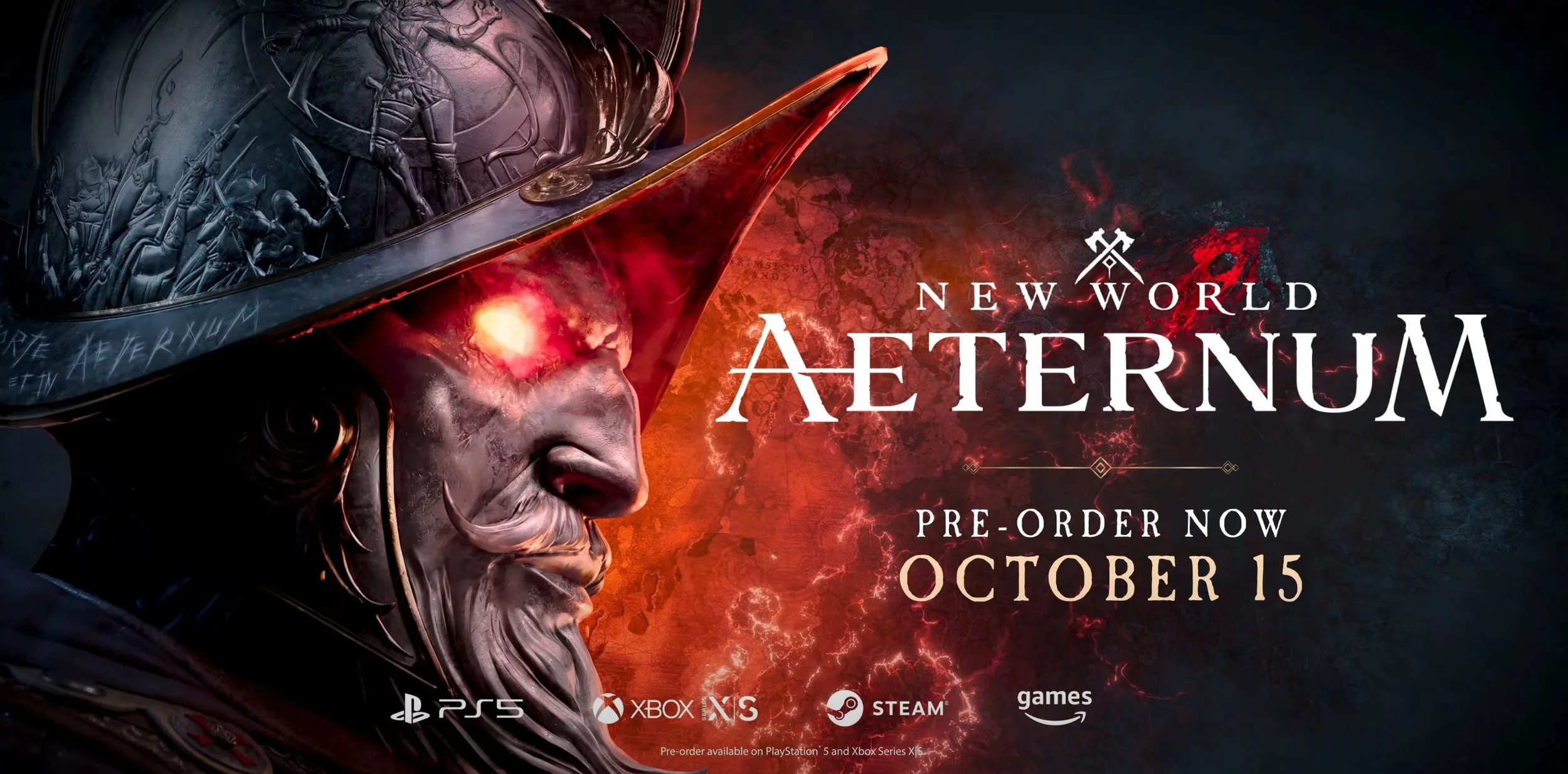Book and PDF Provided by Free League Publishing
When it comes to tabletop role-playing games, many tend to lean towards the fantasy side of the genre. However, Free League Publishing has plenty of other options to check out and one of their latest games is the single-book-sized title Death In Space. Featuring charts and amazing artwork, this game offers a lot of details behind the threats within.
It takes place in a broken world and is about uncertain journeys out into the darkness of space, where the void whispers to the unlucky and imbues travelers’ bodies with strange powers. Best of all, it leaves a lot of the experience and adventure up to the players as it is up to them to make a home of their spacecraft or station - if they survive long enough to do so that is!
Gameplay
Starting off the game, you will need to set up some characters. The character creation chart is diverse enough that it does give you everything you really need to start. Some aspects will be left up to the Game Master (GM), but getting started can be as easy as rolling the dice. Don’t expect to be powerful though because starting off with abilities, you have to roll the same 1d4 twice and the ability score will be the first number subtracted by the second number. So if you roll a 2 and then a 4, your ability score is -2!
When it comes to what is involved in character creation, it is as follows. Abilities Body (BDY), Dexterity (DEX), Savvy (SVY), and Tech (TEC), then you find their Origin, Background, Trait, Drive, special Looks Detail, Past Allegiance, Hit Points, and Defense Rating. Every aspect of the character can be rolled randomly if they don’t want to pick it all out separately.
For health, it is a strict roll of 1d8 and you get what you roll. When the party rests, each character gains 1d8+BDY. For defense, they will get an unarmored defense rating of 12+DEX) - so if you have a negative DEX score, then it will be less than 12.
Once you have all of that setup, it is time to get their starting kit chosen and a personal trinket. For characters whose overall ability scores end up being negative, they also get a starting bonus item. There is also a limited number of item slots which is determined as 12+BDY.
Now, if you are going to run a campaign that includes a spaceship, this can also be created after the players are set up. You have your options of HUB type and frame statistics along with the Power source and output power. There are some starting options, but this part of the game creation process is at the will of the GM. From there, you can start using roll charts to set up the HUB background (separated by Spacecraft and Station), and HUB quirk (such as dimmed lights or shaking violently when the engine runs on maximum).
Once everything is set up, playing the game is a bit different from the standard TTRPG. You have ability checks done as 1d20+ability, but advantage and disadvantage are much more rare and require proper situations to be applied. NPC and creature reactions can be randomized by a dice roll chart. An aspect I really thought was interesting for this game are the void points. A player gets a void point every time they fail an ability or attack roll. They can then use these void points to gain advantage on an ability or attack roll later on, or use it to activate a cosmic mutation. However, if a void point is used to gain advantage and still fails, they get a void corruption which means the player rolls a 1d6 and if they land on a number less than their remaining void points total, they get a void corruption. This is chosen by the GM who will rull a 1d20 and apply from the chart appropriately.
Cosmic Mutations are a physical manifestation of the void through the player's character. These can be obtained as a starting bonus in the character creation process, as a result of player advancement, or in the rare situation when the void has let loose.
As with any vehicle maintenance, there is a focus on the space HUB’s condition and gaining, maintaining, and using spare parts to maintain a positive condition. Hopefully, some players will get an EVA suit because there will be some off-world space walking involved to properly repair everything the ship may need.
Now, of course, this is a space game so there is space travel. In fact, they have a whole solar system in place for you to work with that lists multiple planets that each have their own levels of gravity charted. They even have set up a “safe” path to take while moving through space, but remember that nowhere is truly safe if your GM rolls well enough behind the scenes.
And that brings us to combat! While a lot of people enjoy the role-playing side of these games, combat is an aspect everybody wants to dive into. Much like what you would expect, there is an initiative-based turn order for combat and when an attack is made, it needs to be done with an Attack Roll. There are no proficiencies, so if you are doing a melee attack I had them roll with BDY and if they did a ranged attack they are to roll with TEC as it does specify that TEC is for ranged attacks. Those of us coming from Dungeons & Dragons might lean towards DEX for a ranged attack, but rules, as written, is the argument there.
Players can also go for a Risky Attack, which basically means they can deal more damage to the opponent but then they are exposed to danger and counterattacks. Critical hits, cover, shields, and enemies in combat all work as they usually do. However, weapons do have a condition loss standard which is only applied at the end of a fight. The same goes for a Morale rating which affects the parties reputation.
There are confrontations while on the spacecraft and most of them involve a group entering their ship. Even so, there are ship-to-ship combat moment possibilities, but they aren’t directly placed. A lot of what is noted in the book is to basically flee if you are being attacked, so it seems they don’t recommend fighting ship-to-ship. That said, there is a roll chart for space travel confrontation.
Modules and Enemies
This single-book-sized TTRPG doesn’t contain a lot of actual modules to run, but they do give you a starting story to work with. Welcoming players to ‘The Iron Ring,’ a sector of The Tenebris System where they dock a broken down spacecraft at Aerum 80. Here they will have a few challenges to overcome and worse yet a countdown timer to do so before things get worse. This initial campaign itself definitely shows a lot of what is to be expected from this game because my players did not even make it out of Aerum 80, dying from their first combat moment while one of the players got themselves drugged up on the cheap stuff available and let loose one of the creatures they had in the docking bay (unlucky roll on the creatures hostility chart).
As for the GM’s looking into this option, the book includes a list of creatures for different parts of the campaigns, funny creatures are in this list that are fun to use for moments, a list of triggers for traps, a list of obstacles for in-person and on-ship travel moments, Iron Ring locations, Space Encounters, and Addictive Substances. They also lists of different Spacecrafts, Power Systems, Weapons, Armors, Crews, Non-Player HUBS, Characters, Tech Modules, and General Modules.
This book may not be large, but it has everything you need in order to set up your own space adventure for your players to attempt to complete.
What It Could Have Done Better
Honestly, the combat almost feels TOO harsh. Even with a 1:1 ratio of enemies to players on my team, they still managed to all get wiped out from the first combat sequence itself. I do like how they have it set up, but even as a GM I handed them all weapons right from the start yet they still didn’t manage to win.
I also noticed that there were no stats for melee combat, so I ended up just making it a “Punch or Kick = 1d4” type of situation. But some of the damage just felt off. For instance, one player had a shotgun and shot a guy from point-blank range, but rolled low on damage and left him with 1hp remaining. That same character was then the last one to land an attack against him, killing that player. A shotgun from point-blank range should be a kill, even with rules as written applied.
As a GM, I definitely see a bit of homebrew being required to balance the game according to the party and the situation. Otherwise, it is very easy for them to live up to the name - Death In Space.
For players, do not go into this game thinking combat is anything like the other games you have played! Taking cover, working together, and generally avoiding conflict are some aspects that should be the forefront of your mind and strategy.
Verdict
Death In Space is a hardcore tabletop role-playing game, but if you have a team of players that enjoys role-playing more than combat and would rather see combat as a scary moment to overcome, then this is the TTRPG for you! The starting module they provide is a great way for you to get adjusted to setting up sci-fi-style areas and even includes some small maps to work with. The story within is pretty open for expansion if you wanted to make a whole adventure out of it as well. They did a great job providing a ton of different characters, creatures, locations, modules, and details in order to put plenty of adventures together, but surviving long enough to enjoy a full adventure is something that might be quite challenging without proper combat strategy.
Death In Space is available now physically on the Free League Publishing website and digitally on the DriveThruRPG website.
